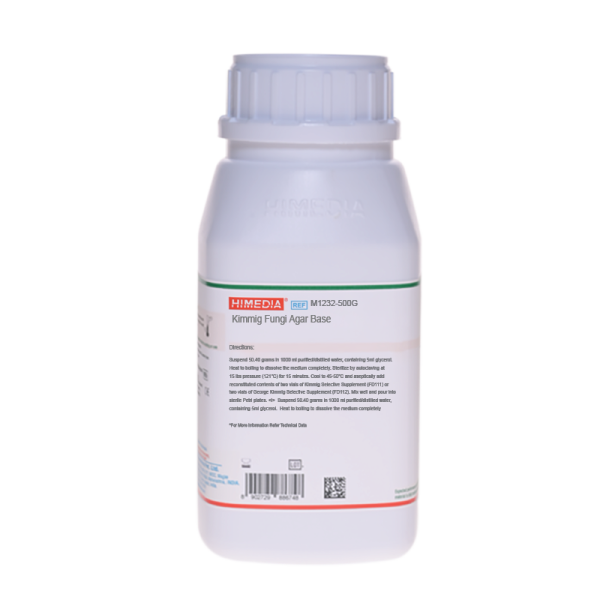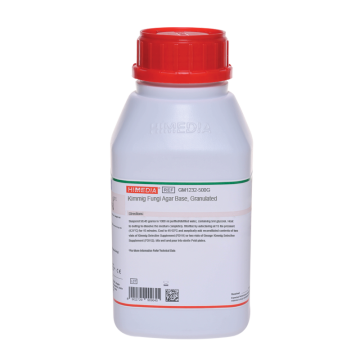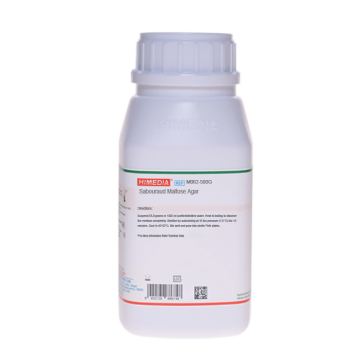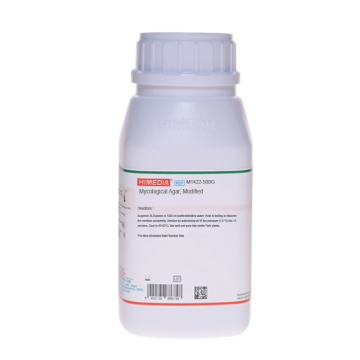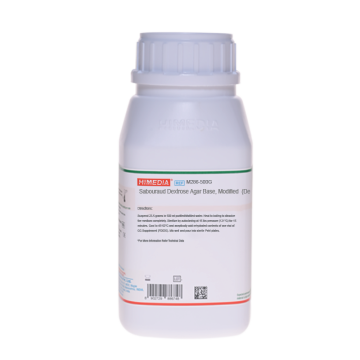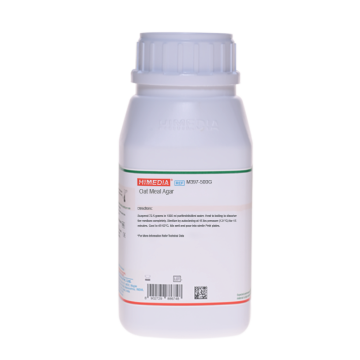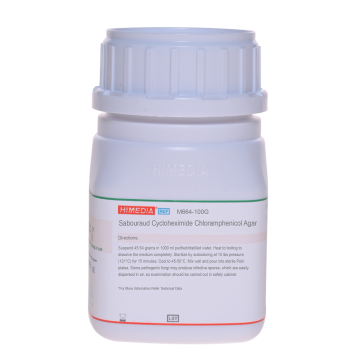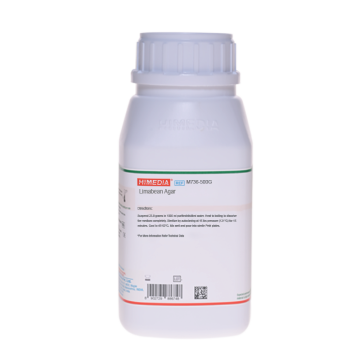 Your enquiry has been submitted
Your enquiry has been submitted
Kimmig Fungi Agar Base
Fungi#CC293D
Intended Use:
Recommended for cultivation, isolation and identification of fungi.
Composition**
| Ingredients | g/L |
|---|---|
| Peptone | 15.000 |
| Sodium chloride | 1.000 |
| Dextrose (Glucose) | 19.000 |
| Cycloheximide | 0.400 |
| Agar | 15.000 |
Final pH (at 25°C) 6.5±0.2
**Formula adjusted, standardized to suit performance parameters
Directions
Suspend 50.40 grams in 1000 ml purified/distilled water, containing 5ml glycerol. Heat to boiling to dissolve the medium completely. Sterilize by autoclaving at 15lbs pressure (121°C) for 15 minutes. Cool to 45-50°C and aseptically add reconstituted contents of two vials of Kimmig Selective Supplement (FD111) or two vials of George Kimmig Selective Supplement (FD112). Mix well and pour into sterile Petri plates.
Principle And Interpretation
Kimmig Fungi Agar is prepared as described by Kimmig and Rieth (1) for cultivation, isolation, identification and strain preservation of fungi. Fungi identification is usually carried out by examining the hyphae or spores formed by fungi on the medium plates. Rieth later stated that this medium promotes the development of growth forms, which are used as important characteristic criteria in identification (2).
The medium contains peptone, which provides the necessary nitrogenous and carbonaceous nutrients, long chain amino acids, vitamins for the growth of fungi. Dextrose is the fermentable carbohydrate and energy source. Glycerol serves as the carbon source. Kimmig Fungi Agar Base is used as a base for preparation of selective agars for isolation of fungi from heavily contaminated materials. George et al (3) suggested addition of cycloheximide, penicillin and streptomycin while Hantschke (4) suggested the use of colistin and novobiocin.
Type of specimen
Clinical samples - skin or nail scraping or infected hair etc
Specimen Collection and Handling:
For clinical samples follow appropriate techniques for handling specimens as per established guidelines (5,6).
After use, contaminated materials must be sterilized by autoclaving before discarding.
Warning and Precautions
In Vitro diagnostic Use only. For professional use only. Read the label before opening the container. Wear protective gloves/protective clothing/eye protection/face protection. Follow good microbiological lab practices while handling specimens and culture. Standard precautions as per established guidelines should be followed while handling clinical specimens. Safety guidelines may be referred in individual safety data sheets.
Limitations :
- Individual organisms differ in their growth requirement and may show variable growth patterns on the medium.
- Each lot of the medium has been tested for the organisms specified on the COA. It is recommended to users to validate the medium for any specific microorganism other than mentioned in the COA based on the user's unique requirement. Further biochemical and serological tests must be carried out for further identification.
Performance and Evaluation
Performance of the medium is expected when used as per the direction on the label within the expiry period when stored at recommended temperature.
Quality Control
Appearance Cream to yellow homogeneous free flowing powder
Gelling Firm, comparable with 1.5% Agar gel
Colour and Clarity of prepared medium Light yellow coloured, clear to slightly opalescent gel forms in Petri plates
Reaction Reaction of 5.04% w/v aqueous solution at 25°C. pH: 6.5±0.2
pH 6.30-6.70
Cultural Response
Cultural characteristics observed with added Kimmig Supplement (FD111) or George Kimmig Selective Supplement (FD112), after an incubation at 25-30°C for 48-72 hours.
| Organism | Growth |
|---|---|
| #Aspergillus brasiliensis ATCC 16404 (00053*) | luxuriant |
| Candida albicans ATCC 10231 (00054*) | luxuriant |
| Pencillium notatum ATCC 10108 | luxuriant |
| Trichophyton mentagrophytes ATCC 9533 | luxuriant |
Key: *Corresponding WDCM numbers. # Formerly known as Aspergillus niger
Storage and Shelf Life
Store dehydrated and the prepared medium at 2-8°C. Use before expiry date on the label. On opening, product should be properly stored dry, after tightly capping the bottle in order to prevent lump formation due to the hygroscopic nature of the product. Improper storage of the product may lead to lump formation. Store in dry ventilated area protected from extremes of temperature and sources of ignition. Seal the container tightly after use. Product performance is best if used within stated expiry period.
Disposal
User must ensure safe disposal by autoclaving and/or incineration of used or unusable preparations of this product. Follow established laboratory procedures in disposing of infectious materials and material that comes into contact with sample must be decontaminated and disposed of in accordance with current laboratory techniques (5,6).
Reference
- Kimmig J. and Rieth H., 1953, Arzneimittelforsch, 3:267.
- Rieth H., 1969, Mykosen, 12: 73.
- George L. K., Ajello L. and Papageorge C., 1954, J. Lab. Clin. Med., 44.422.
- Hantschke D., 1968, Mykosen, 11:769.
- Isenberg, H.D. Clinical Microbiology Procedures Handbook 2nd Edition.
- Jorgensen, J.H., Pfaller, M.A., Carroll, K.C., Funke, G., Landry, M.L., Richter, S.S and Warnock., D.W. (2015) Manual of Clinical Microbiology, 11th Edition. Vol. 1.
| Product Name | Kimmig Fungi Agar Base |
|---|---|
| SKU | M1232 |
| Product Type | Regular |
| Physical Form | Powder |
| Origin | Animal |
| Packaging type | HDPE |
| References | 1.Kimmig J. and Rieth H., 1953, Arzneimittelforsch, 3:267.2.Rieth H., 1969, Mykosen, 12: 73.3.George L. K., Ajello L. and Papageorge C., 1954, J. Lab. Clin. Med., 44.422.4.Hantschke D., 1968, Mykosen, 11:769. |
| Customized Product Available | No |



